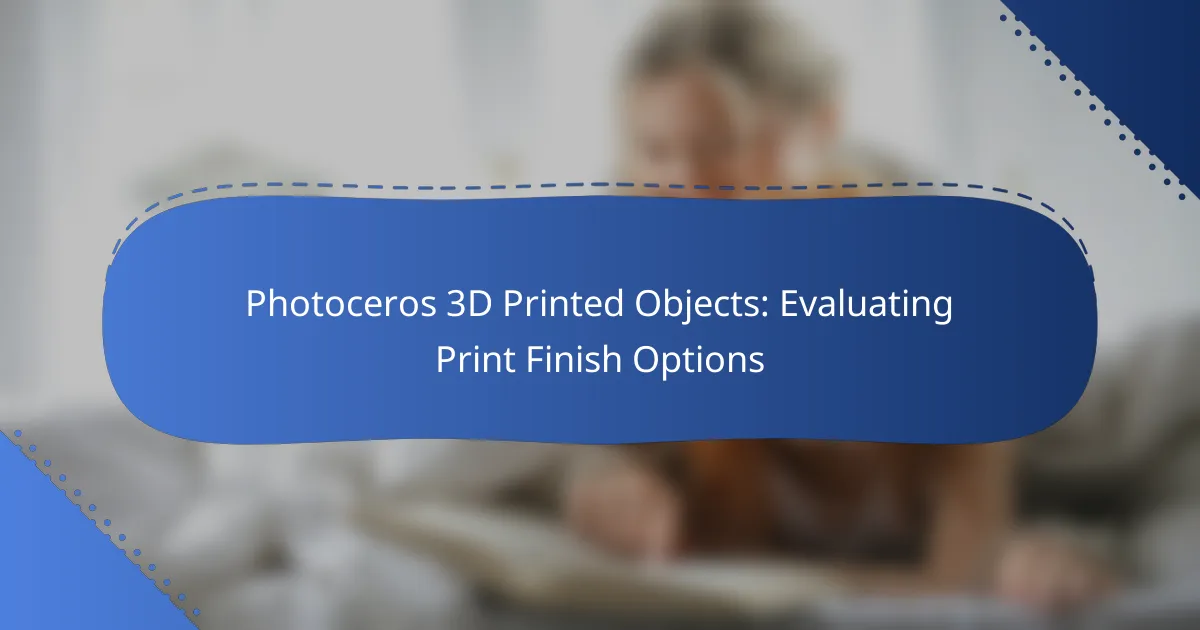When it comes to Photoceros 3D printed objects, selecting the right print finish is crucial for achieving the desired aesthetic and functional qualities. Options such as matte, glossy, satin, and textured finishes each provide unique visual and tactile effects, influencing the overall look and feel of the final product. Additionally, the durability of these finishes can vary, impacting the longevity and usability of the printed items.
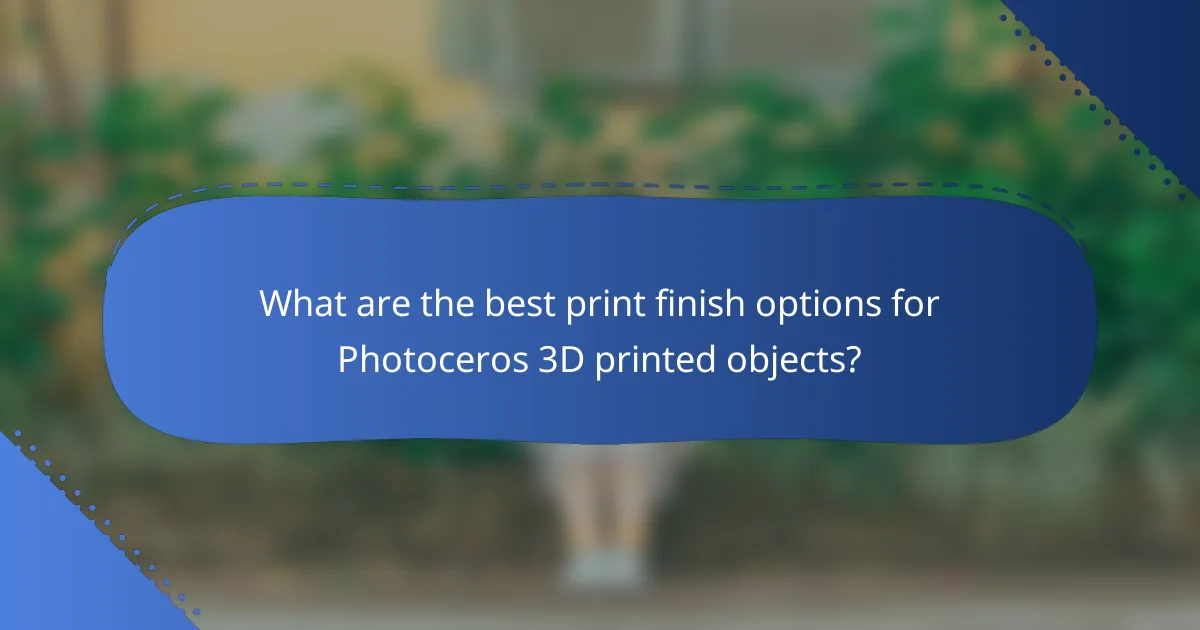
What are the best print finish options for Photoceros 3D printed objects?
The best print finish options for Photoceros 3D printed objects include matte, glossy, satin, and textured finishes. Each finish offers distinct visual and tactile characteristics that can enhance the final appearance of the printed item, depending on the intended use and aesthetic preference.
Matte finish
A matte finish provides a non-reflective surface that minimizes glare and enhances the visibility of details. This finish is ideal for objects where a subtle, understated look is desired, such as architectural models or prototypes.
When choosing a matte finish, consider using a post-processing technique like sanding or applying a matte spray. These methods can help achieve a consistent texture and reduce any shine that might detract from the design.
Glossy finish
A glossy finish creates a shiny, reflective surface that can make colors appear more vibrant and details more pronounced. This finish is often preferred for decorative items or display pieces, as it adds a polished look.
To achieve a glossy finish, you can use a clear coat or resin application. Be cautious, as excessive gloss can sometimes obscure fine details, so test on a small area first to ensure it meets your expectations.
Satin finish
The satin finish strikes a balance between matte and glossy, offering a soft sheen that enhances colors without overwhelming reflections. This finish is versatile and works well for both functional and aesthetic purposes.
To create a satin finish, consider using satin varnish or a combination of sanding and polishing techniques. This approach can help you achieve the desired effect while maintaining the integrity of the printed details.
Textured finish
A textured finish adds depth and tactile interest to 3D printed objects, making them more engaging to touch and view. This finish is suitable for items like sculptures or art pieces where the surface quality plays a significant role in the overall design.
To achieve a textured finish, you can use specific printing techniques or apply materials that create surface variations. Be mindful of how texture affects the object’s functionality, especially if it needs to fit with other components or surfaces.
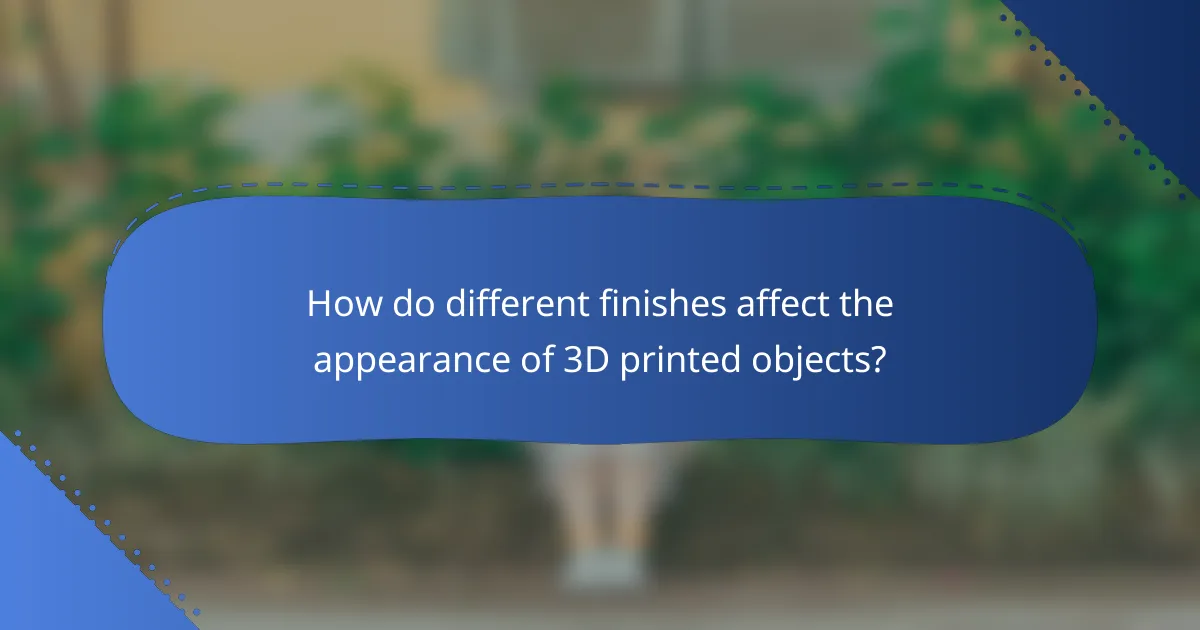
How do different finishes affect the appearance of 3D printed objects?
Different finishes can significantly alter the appearance of 3D printed objects by enhancing or diminishing features such as color, texture, and light interaction. The choice of finish impacts not only aesthetics but also the perceived quality and usability of the printed item.
Impact on color vibrancy
The finish applied to a 3D printed object can greatly influence its color vibrancy. Glossy finishes tend to enhance color saturation, making hues appear more vivid, while matte finishes can soften colors, leading to a more subdued look. For optimal vibrancy, consider using a clear coat or resin that enhances the underlying color without obscuring details.
When selecting a finish, it’s essential to test samples, as different materials may react uniquely to various coatings. For instance, PLA may show different vibrancy levels compared to ABS when finished with the same product.
Surface smoothness
Surface smoothness is crucial for both aesthetics and functionality in 3D printed objects. Smoother finishes can reduce the visibility of layer lines, resulting in a more polished appearance. Techniques such as sanding, polishing, or applying a filler can achieve this effect, but they require careful execution to avoid damaging the print.
For best results, consider the type of filament used and the intended use of the object. Functional parts may benefit from a smoother finish for better fit and performance, while decorative items might prioritize visual appeal.
Light reflection properties
The light reflection properties of a finish can dramatically affect how a 3D printed object is perceived in different lighting conditions. Glossy finishes reflect more light, creating highlights that can enhance details, while matte finishes diffuse light, resulting in a softer appearance. This choice can influence not only aesthetics but also the object’s visibility in various environments.
When deciding on a finish, consider the lighting conditions where the object will be displayed or used. For example, items intended for bright environments may benefit from a glossy finish to catch the eye, while those in subdued lighting might look better with a matte finish to reduce glare.

What are the durability differences between print finishes?
The durability of print finishes varies significantly based on their composition and application. Key factors include scratch resistance, UV resistance, and how well the finish holds up over time, all of which affect the longevity and appearance of 3D printed objects.
Scratch resistance
Scratch resistance is a critical factor in determining how well a print finish can withstand physical contact and abrasion. Finishes like epoxy or polyurethane tend to offer superior scratch resistance compared to standard PLA or ABS coatings. For everyday items, consider finishes that provide a hard surface to minimize visible wear.
When evaluating scratch resistance, look for products that specify their hardness rating. A finish rated above 5H on the pencil hardness scale is generally considered durable for most applications.
UV resistance
UV resistance is essential for items exposed to sunlight, as UV rays can degrade materials over time. Finishes with UV stabilizers, such as certain acrylics or specialized coatings, can significantly extend the life of your prints when used outdoors. Without adequate UV protection, colors may fade, and structural integrity can diminish.
For outdoor applications, opt for finishes specifically labeled as UV resistant. Regular maintenance, including reapplication of UV coatings, can further enhance durability.
Wear over time
Wear over time is influenced by both the material used and the environment in which the object is placed. Some finishes may show signs of wear within months, while others can last for years with proper care. High-traffic items, like handles or toys, require finishes that can endure frequent use without degrading.
To maximize longevity, choose finishes that are designed for high wear applications and consider environmental factors such as humidity and temperature fluctuations that may affect durability. Regular inspections and touch-ups can help maintain the appearance and functionality of your prints.
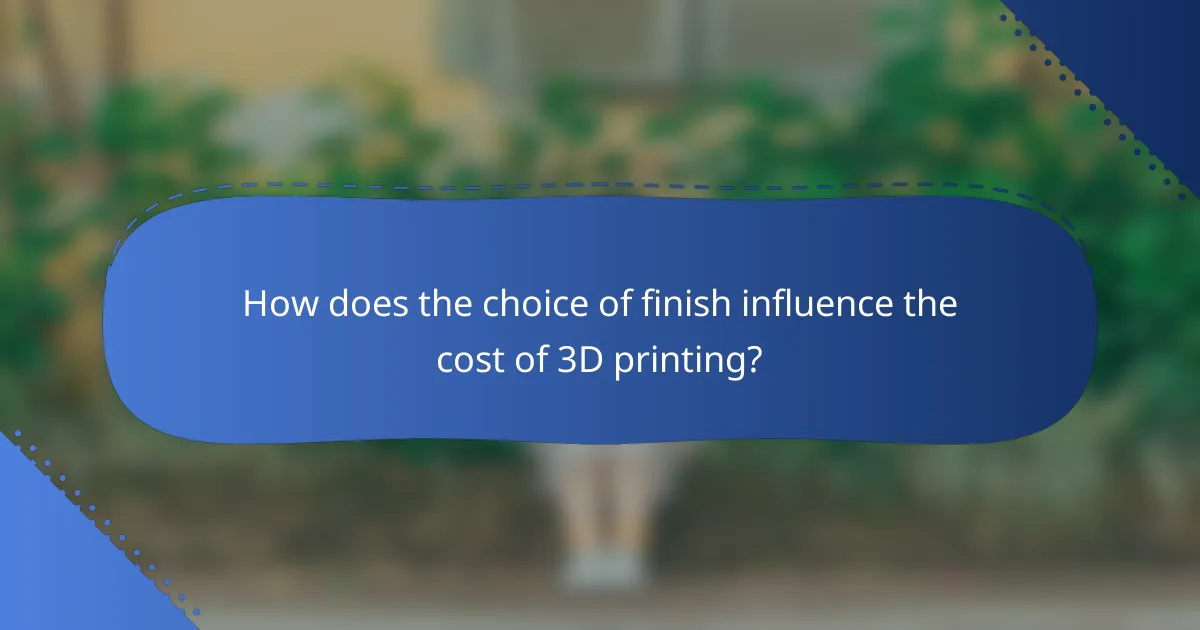
How does the choice of finish influence the cost of 3D printing?
The choice of finish significantly impacts the overall cost of 3D printing by affecting material usage, labor intensity, and production time. Higher quality finishes often require more expensive materials and additional processing steps, which can increase both direct and indirect costs.
Material costs
Different finishes require varying types of materials, which can lead to significant cost differences. For instance, a basic matte finish may use standard filament, while a glossy or textured finish might necessitate specialty materials that are more expensive. It’s essential to evaluate the material costs associated with each finish option to understand its impact on the overall budget.
Additionally, some finishes may require post-processing materials, such as paints or coatings, which can further inflate costs. Budgeting for these materials is crucial when selecting a finish.
Labor costs
The complexity of the finishing process can lead to higher labor costs. Finishes that require extensive sanding, painting, or assembly will demand more time and skilled labor, increasing the overall expense. For example, a simple polish may take less time compared to a multi-step painting process.
It’s advisable to assess the labor requirements for each finish type and factor those into the total cost. This can help in making informed decisions that align with budget constraints.
Time efficiency
Time efficiency is a critical factor in the cost of 3D printing finishes. More intricate finishes typically require longer production times, which can delay project timelines and increase labor costs. For instance, a quick spray finish might be completed in a few hours, while a detailed hand-painted finish could take several days.
To optimize costs, consider balancing the desired finish quality with the time available for production. Quick finishes may be more cost-effective for projects with tight deadlines, while high-quality finishes can be reserved for more critical applications.
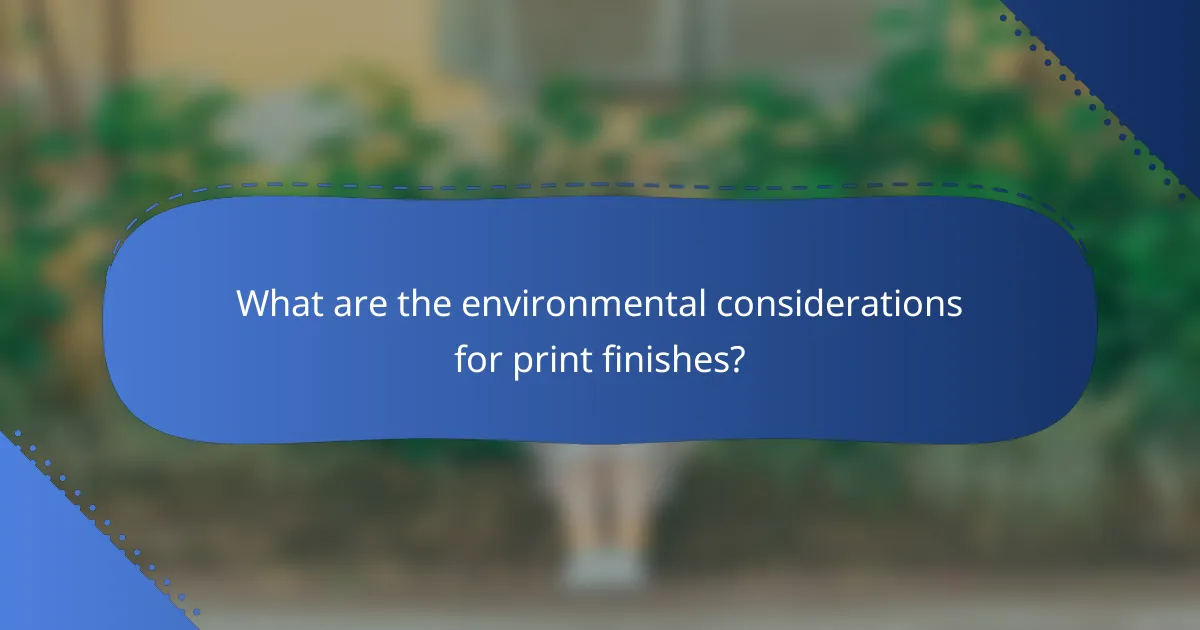
What are the environmental considerations for print finishes?
Environmental considerations for print finishes include the impact of materials used and their end-of-life options. Evaluating biodegradability and recyclability helps determine the sustainability of 3D printed objects.
Biodegradability of materials
Biodegradability refers to the ability of materials to decompose naturally over time, reducing their environmental footprint. Many traditional 3D printing materials, such as certain plastics, can take hundreds of years to break down, posing significant waste challenges.
In contrast, biodegradable materials like PLA (polylactic acid) are derived from renewable resources and can decompose within a few months under the right conditions. When selecting materials, consider their compostability certifications and local composting facilities to ensure proper disposal.
Recyclability
Recyclability indicates whether a material can be processed and reused after its initial life cycle. Many thermoplastics used in 3D printing, such as ABS and PETG, are recyclable, but the availability of recycling programs can vary by region.
To enhance recyclability, check for local recycling guidelines and ensure that the materials you choose are accepted. Some companies offer take-back programs for 3D printed items, allowing for responsible recycling and reducing landfill contributions.
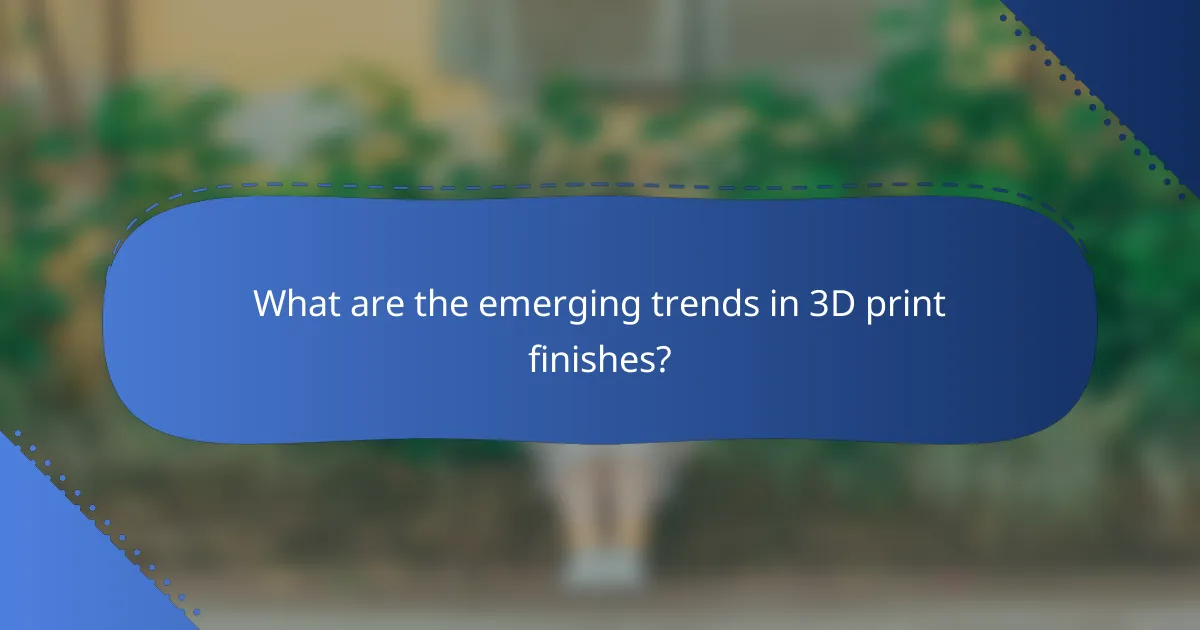
What are the emerging trends in 3D print finishes?
Emerging trends in 3D print finishes focus on enhancing aesthetics, durability, and functionality of printed objects. Innovations in materials and techniques are allowing for more versatile and appealing surface treatments that cater to various applications.
Advanced Surface Treatments
Advanced surface treatments are gaining popularity as they improve both the look and feel of 3D printed items. Techniques such as vapor smoothing, sandblasting, and chemical polishing can significantly enhance the finish, making it smoother and more visually appealing.
For instance, vapor smoothing can reduce the layer lines typically seen in FDM prints, resulting in a more polished appearance. This method is particularly effective for materials like ABS and PLA, where the surface can be treated to achieve a glossy finish.
Textured Finishes
Textured finishes are becoming a sought-after option for adding tactile elements to 3D printed objects. These finishes can be achieved through specialized printing techniques or post-processing methods that create unique patterns and surfaces.
Using textured finishes can enhance grip and usability, making them ideal for products like tool handles or consumer goods. Additionally, they can provide a distinctive aesthetic that sets a product apart in the market.
Eco-Friendly Finishing Options
As sustainability becomes increasingly important, eco-friendly finishing options are emerging in the 3D printing industry. These options include biodegradable coatings and water-based finishes that minimize environmental impact.
Choosing eco-friendly finishes not only supports sustainable practices but can also appeal to environmentally conscious consumers. Brands that adopt these methods may find a competitive edge in the growing market for green products.
Customization and Personalization
Customization and personalization in 3D print finishes are on the rise, allowing consumers to tailor products to their preferences. This trend is facilitated by advancements in digital printing technologies that enable unique designs and finishes for individual orders.
For example, customers can select specific colors, textures, or patterns that resonate with their personal style. This level of customization enhances user satisfaction and can lead to increased brand loyalty.
